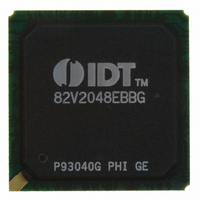IDT82V2048EBBG IDT, Integrated Device Technology Inc, IDT82V2048EBBG Datasheet - Page 17

IDT82V2048EBBG
Manufacturer Part Number
IDT82V2048EBBG
Description
IC LINE INTERFACE UNIT 208-PBGA
Manufacturer
IDT, Integrated Device Technology Inc
Type
Line Interface Units (LIUs)r
Datasheet
1.IDT82V2048EBBG.pdf
(76 pages)
Specifications of IDT82V2048EBBG
Protocol
E1
Voltage - Supply
3.13 V ~ 3.47 V
Mounting Type
Surface Mount
Package / Case
208-PBGA
Screening Level
Industrial
Mounting
Surface Mount
Operating Temperature (min)
-40C
Operating Temperature (max)
85C
Lead Free Status / RoHS Status
Lead free / RoHS Compliant
Number Of Drivers/receivers
-
Lead Free Status / RoHS Status
Compliant, Lead free / RoHS Compliant
Other names
800-1704
82V2048EBBG
82V2048EBBG
Available stocks
Company
Part Number
Manufacturer
Quantity
Price
Company:
Part Number:
IDT82V2048EBBG
Manufacturer:
IDT
Quantity:
5
Company:
Part Number:
IDT82V2048EBBG
Manufacturer:
IDT Integrated Device Technolo
Quantity:
135
Company:
Part Number:
IDT82V2048EBBG
Manufacturer:
NSC
Quantity:
60
Company:
Part Number:
IDT82V2048EBBG
Manufacturer:
IDT, Integrated Device Technology Inc
Quantity:
10 000
OCTAL CHANNEL T1/E1/J1 SHORT HAUL LINE INTERFACE UNIT
‘0111’.
3.2.3.2 User-Programmable Arbitrary Waveform
waveform generator mode can be used in the corresponding channel. This
allows the transmitter performance to be tuned for a wide variety of line con-
dition or special application.
UI[1:0] bits (TCF3, 05H...) and each UI is divided into 16 sub-phases,
addressed by the SAMP[3:0] bits (TCF3, 05H...). The pulse amplitude of
each phase is represented by a binary byte, within the range from +63 to -
63, stored in WDAT[6:0] bits (TCF4, 06H...) in signed magnitude form. The
most positive number +63 (D) represents the maximum positive amplitude
of the transmit pulse while the most negative number -63 (D) represents the
maximum negative amplitude of the transmit pulse. Therefore, up to 64
bytes are used. For each channel, a 64 bytes RAM is available.
User can select one of them as reference and make some changes to get
the desired waveform.
pulse shape. In order to do this, firstly, users can choose a set of waveform
value from the following eight tables, which is the most similar to the desired
pulse shape. Table-2, Table-3, Table-4, Table-5, Table-6, Table-7,
and
plates. Then modify the corresponding sample data to get the desired trans-
mit pulse shape.
by 1, the pulse amplitude can be scaled up or down at the percentage ratio
against the standard pulse amplitude if needed. For different pulse shapes,
the value of SCAL[5:0] bits and the scaling percentage ratio are different.
The following eight tables list these values.
grammed, based on the selected waveform template:
Note: R
For J1 applications, the PULS[3:0] (TCF1, 03H...) should be set to
When the PULS[3:0] bits are set to ‘11xx’, user-programmable arbitrary
Each pulse shape can extend up to 4 UIs (Unit Interval), addressed by
There are eight standard templates which are stored in a local ROM.
User can change the wave shape and the amplitude to get the desired
Secondly, through the value of SCAL[5:0] bits increased or decreased
Do the followings step by step, the desired waveform can be pro-
(1).Select the UI by UI[1:0] bits (TCF3, 05H...)
(2).Specify the sample address in the selected UI by SAMP [3:0] bits
(3).Write sample data to WDAT[6:0] bits (TCF4, 06H...). It contains the
IDT82V2048E
Table-9
(TCF3, 05H...)
data to be stored in the RAM, addressed by the selected UI and the
corresponding sample address.
Table-10
LOAD
Figure-7 T1 Pulse Template Test Circuit
list the sample data and scaling data of each of the eight tem-
= 100 Ω ± 5%
lists these values.
TTIPn
TRINGn
Cable
R
LOAD
Table-8
V
OUT
17
from the internal RAM.
lap of two consecutive pulses could make the pulse amplitude overflow
(exceed the maximum limitation) if the pulse amplitude is not set properly.
This overflow is captured by DAC_OV_IS bit (INTS1, 17H...), and, if
enabled by the DAC_OV_IM bit (INTM1, 12H...), an interrupt will be gen-
erated.
templates in detail for reference. For preset pulse templates, scaling up/
down against the pulse amplitude is not supported.
Table-2 Transmit Waveform Value For E1 75 Ω
SCAL[5:0] = 100001 (default), One step change of this value of SCAL[5:0]
results in 3% scaling up/down against the pulse amplitude.
(4).Set the RW bit (TCF3, 05H...) to ‘0’ to implement writing data to RAM,
(5).Implement the Read from RAM/Write to RAM by setting the DONE
Repeat the above steps until all the sample data are written to or read
(6).Write the scaling data to SCAL[5:0] bits (TCF2, 04H...) to scale the
When more than one UI is used to compose the pulse template, the over-
The following tables give all the sample data based on the preset pulse
1.Table-2
2.Table-3
3.Table-4
4.Table-5
5.Table-6
6.Table-7
7.Table-8
8.Table-9
Sample
10
12
13
14
15
16
11
or to ‘1’ to implement read data from RAM
bit (TCF3, 05H...)
amplitude of the waveform based on the selected standard pulse
amplitude
1
2
3
4
5
6
7
8
9
Transmit Waveform Value For E1 75 Ω
Transmit Waveform Value For E1 120 Ω
Transmit Waveform Value For T1 0~133 ft
Transmit Waveform Value For T1 133~266 ft
Transmit Waveform Value For T1 266~399 ft
Transmit Waveform Value For T1 399~533 ft
Transmit Waveform Value For T1 533~655 ft
Transmit Waveform Value For J1 0~655 ft
0000000
0000000
0000000
0000000
0000000
0000000
0000000
0001100
0110000
0110000
0110000
0110000
0110000
0110000
0110000
0110000
UI 1
0000000
0000000
0000000
0000000
0000000
0000000
0000000
0000000
0000000
0000000
0000000
0000000
0000000
0000000
0000000
0000000
UI 2
TEMPERATURE RANGES
0000000
0000000
0000000
0000000
0000000
0000000
0000000
0000000
0000000
0000000
0000000
0000000
0000000
0000000
0000000
0000000
UI 3
INDUSTRIAL
0000000
0000000
0000000
0000000
0000000
0000000
0000000
0000000
0000000
0000000
0000000
0000000
0000000
0000000
0000000
0000000
UI 4
















